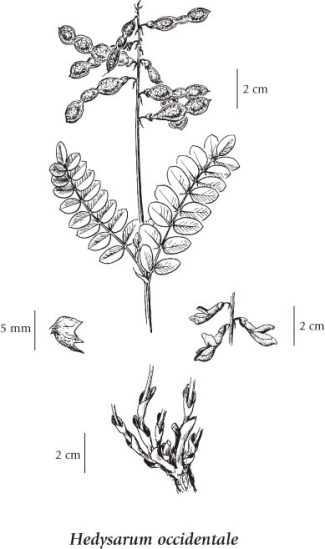Hedysarum occidentale Greene
western hedysarum (western sweetvetch; western sweet-vetch)
Fabaceae (Pea family)
Introduction to Vascular Plants
western hedysarum (western sweetvetch; western sweet-vetch)
Fabaceae (Pea family)
Introduction to Vascular Plants
Species Information
General:
Perennial herb from a branched, woody stem-base and heavy taproot; stems several, erect, 40-80 cm tall, branched above, sparsely short-hairy.
Leaves:
Alternate, odd-pinnate, mostly glabrous, sometimes thinly short-hairy below, minutely gland-dotted on the upper surface; leaflets 9 to 21, lanceolate to elliptic, conspicuously veined, 10-40 mm long; stipules membranous, brownish, lower ones joined, up to 3 cm long, upper ones usually free.
Flowers:
Inflorescence an axillary, often one-sided raceme of 20 to 80 pea-like, nodding flowers; corollas reddish-purple, 16-22 mm long, the wing lobes linear and nearly equal to the claw; calyces 4-5 mm long, short-hairy, the teeth shorter than the tube, the upper pair of teeth wider and shorter than the lower three.
Fruits:
Pods, constricted between the seeds into (1) 2 to 4 segments, the segments egg-shaped to elliptic, 7-12 mm wide, delicately and irregularly net-veined, the margins winged, 1-2 mm wide.
Illustration

If more than one illustration is available for a species (e.g., separate illustrations were provided for two subspecies) then links to the separate images will be provided below. Note that individual subspecies or varietal illustrations are not always available.
Illustration Source: The Illustrated Flora of British Columbia